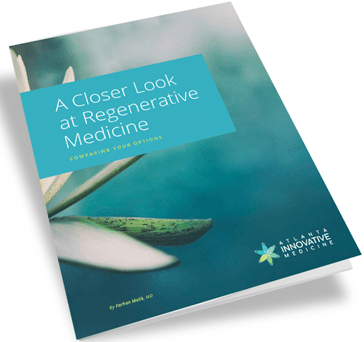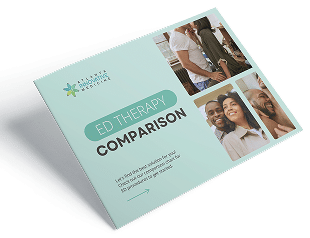By Farhan Malik, MD
Atlanta Innovative Medicine
Getting a good night’s rest while recovering from a rotator cuff injury can be tough. In this comprehensive guide, we explore why rotator cuff pain worsens at night and offer practical strategies to alleviate discomfort so you can sleep better and recover faster. From adapting your sleep position to incorporating hot/cold therapy and rehabilitative exercises, discover how to ease pain and support your body’s healing process.
When rotator cuff pain gets in the way of your sleep, it’s not just a nuisance—it’s a barrier to the healing process. During sleep, your body releases growth hormone which promotes tissue regeneration and repair—a process critical to recovery. Without sufficient sleep, your body’s ability to heal itself becomes compromised.
Not only this, but sleep supports your immune function, as well as conserves energy for other repair processes, like protein synthesis and cell turnover. By alleviating rotator cuff pain, you can not only ease discomfort but promote better sleep, which in turn accelerates recovery.
Of course alleviating pain at night can be challenging when sleep involves direct impact with the injured area. In this blog, we’ll discuss practical strategies for minimizing rotator cuff pain to secure a good night’s rest, as well as look at other rehabilitative techniques for a faster and fuller recovery.

What Causes Rotator Cuff Pain?
Rotator cuff pain is caused by the overstretching or tearing of the muscles and tendons that comprise the rotator cuff. The most common tendon injury treated in adults, rotator cuff injuries can happen suddenly during sports-related impacts, falls, or other accidents; or they can develop gradually over time due to repetitive stress or degenerative illness.
Because of the rotator cuff’s susceptibility to degeneration, age is a significant factor in rotator cuff injury risk. In fact, rotator cuff tears are twice as prevalent in adults aged 80 compared to those aged 60—and six times compared to those aged 20 or younger.
Other risk factors for rotator cuff injury include poor posture, muscle imbalances, and especially, tissue trauma. Insufficient healing of a rotator cuff injury increases susceptibility to future injuries and degeneration, underscoring the importance of proper recovery.
Rotator Cuff Strain vs Tear
While a tear involves a partial or complete tear of a tendon or muscle, a rotator cuff strain involves just overstretching. The most common rotator cuff injury is a supraspinatus muscle tear, a tear of the tendon within the supraspinatus muscle.
Why Is Rotator Cuff Pain Worse at Night?
If you’ve noticed your rotator cuff pain tends to worsen at night, you’re not imagining things. A number of factors can increase pain during sleep including inflammation, stiffness, and blood flow.
During sleep, your blood circulation fluctuates significantly, not only contributing to inflammation, but allowing less oxygen and fewer nutrients to reach the injured tissues, which, in turn, exacerbates pain. Additionally, when you lie down to sleep, fluid is redistributed throughout your body; and as you lie still, it can pool up in certain areas, increasing inflammation and discomfort around your injury.
Plus, as you sleep, muscles and soft tissues start to become stiff due to inactivity, and this can compound the discomfort and pain caused by inflammation.
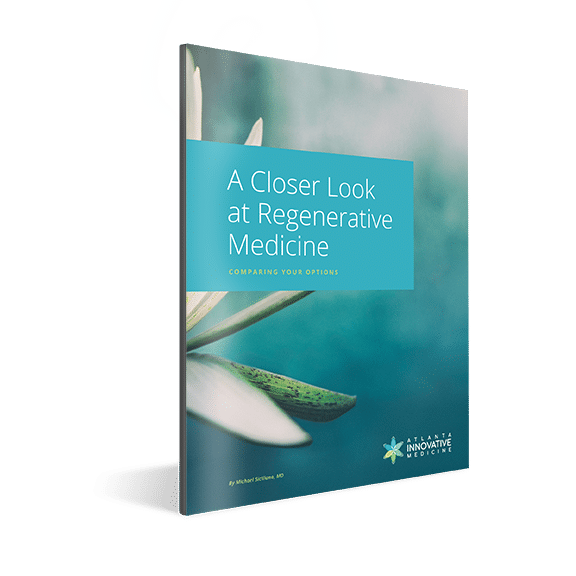
Subscribe for Expert Insights and Our Ebook
A Closer Look at Regenerative Medicine: Comparing Your Options Learn about treatment options like Platelet Rich Plasma (PRP), Prolozone Therapy, and Stem Cell Therapy.
How to Relieve Rotator Cuff Pain at Night
Because the body’s natural nighttime activity and healing processes tend to increase pain, sleeping with a rotator cuff injury doesn’t come easily. However, with a little improvising of your sleep environment, it’s possible to relieve rotator cuff pain and achieve a good night’s rest.
Adjusting the Way You Sleep
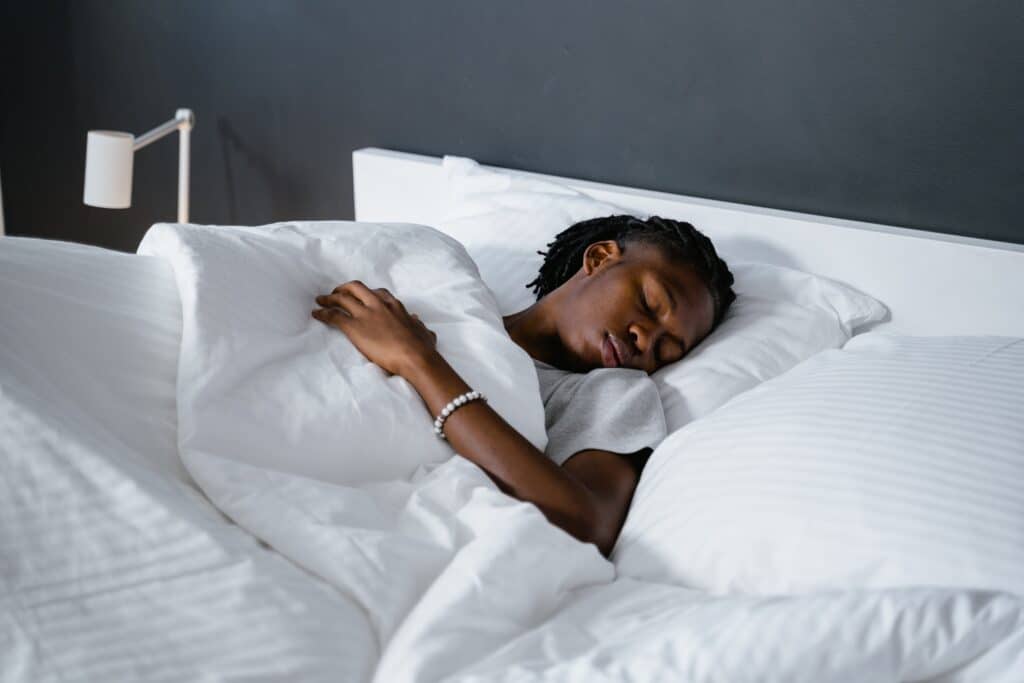
One of the most effective ways to relieve rotator cuff pain at night is to adjust your sleeping position. Because of the rotator cuff’s location in your body, many sleep positions exert constant pressure on the injury, increasing the pain caused by inflammation and stiffness. However, there are a few effective ways to adapt your sleep position for a rotator cuff injury.
How Should I Sleep if My Rotator Cuff Hurts?
The best position to relieve rotator cuff pain is the one that alleviates the most pressure from your injured shoulder. There are a few ways to achieve this:
Sleep on Your Back: This is a great place to start. It alleviates much of the direct pressure on your rotator cuff, while also preventing strain in the surrounding muscles. If you struggle to sleep on your back, here a couple ways to make it more comfortable:
Recline: Sleeping in a reclined position will alleviate even more of the pressure on your shoulders. You can do this by sleeping in a recliner or placing pillows behind your shoulders and head to prop yourself up.
Elevate Your Shoulder: It might not seem possible to elevate your shoulder effectively, but in fact, even slight elevation can help reduce swelling throughout the night. Use one of your pillows or a folded towel to prop your shoulder up as far as is comfortable.
Hot and Cold Therapy
Hot and cold therapy is another great way to reduce swelling, relax your muscles, and ease pain for sleep. While icing your shoulder will not provide immediate relief, it can reduce swelling, which will ultimately help relieve your rotator cuff pain throughout the night. On the other hand, applying a heating pad to your shoulder can help ease your pain right away by relaxing tension in your muscles and tendons.
The best hot/cold routine will depend on your precise injury, but here’s one standard regimen to support pain relief at night:
- Throughout the day, about every 4–6 hours, ice your shoulder for 10–20 minutes, then apply heat for another 10–20 minutes.
- Shortly before you go to bed, ice your shoulder for 10–20 minutes.
- As you go to sleep, apply heat.
Is Heat Good for Rotator Cuff Pain?
With both heat and cold therapy, it’s important to be cognizant of your injury’s level of inflammation. While heat alleviates tension, it also increases inflammation. While cold alleviates inflammation, it also increases tension. Because of this, you may want to use less heat when inflammation is high. However, if your inflammation is well controlled, and you notice that a heat pad helps you relax, this is a great way to relieve rotator cuff pain and support your sleep.
Do these symptoms sound familiar?
Book an appointment to learn how we can help you identify and treat the cause of your symptoms.

Stretching and Strengthening

One of the main contributing factors to rotator cuff pain at night is tension, which is caused by stiffness and muscle weakness. Because of this, gently expanding flexibility and slowly rebuilding muscle strength can significantly alleviate your rotator cuff pain at night.
Stretches for Torn Rotator Cuff Pain Relief
The most effective strategy for pain relief involves movement throughout the day, as well as gentle stretching before bed. While the best movements for your unique injury will vary, here are some common stretches designed to release tension throughout the day and ease rotator cuff pain before sleep.
Crossover Arm Stretch: Stretches the posterior deltoid, infraspinatus, and teres minor muscles within the rotator cuff to alleviate direct tension.
- Stand tall and bring one arm across your body at shoulder height.
- Use your opposite hand to gently pull the stretching arm toward your chest.
- Hold the stretch for 15–30 seconds, keeping a gentle pull in the shoulder.
- Repeat on the other side.
Doorway Stretch: Stretches the pectoral muscle (which pulls the shoulders forward when tight) to correct forward posture and relieve strain on the rotator cuff muscles.
- Stand in a doorway with one hand on the door frame at shoulder height.
- Step forward with one foot, allowing your body to gently stretch forward until you feel a stretch across the front of the shoulder.
- Hold the stretch for 15–30 seconds.
- Repeat on the other side.
Sleeper Stretch: Stretches the rotator cuff muscles to reduce compression on the tendons and expand range of motion.
- Lie on your side with the injured shoulder on the bottom.
- Bend your elbow to 90 degrees and place it in front of you.
- Use your opposite hand to gently press down on the forearm until you feel a stretch in the back of your shoulder.
- Hold for 15–30 seconds.
- Repeat on the other side.

Arm Wall Slide: Stretches various muscles in the upper back and around the shoulder joint, alleviating the stiffness stemming from a rotator cuff injury.
- Stand with your back against a wall, feet shoulder-width apart.
- Bend your elbows to 90 degrees with the backs of your hands against the wall and palms facing forward.
- Slowly slide your arms up the wall as far as comfortable, keeping elbows and wrists in contact with the wall.
- Hold for a few seconds, then slide back down.
- Repeat for 10–15 repetitions
Pendulum Exercise: Stretches various shoulder muscles, while promoting circulation throughout the rotator cuff.
- Lean over slightly, using your uninjured arm to support yourself on a table or chair.
- Let your injured arm hang down and gently swing it back and forth, side to side, and in circles.
- Perform this motion for 1–2 minutes.
How Can I Rehab My Rotator Cuff at Home?
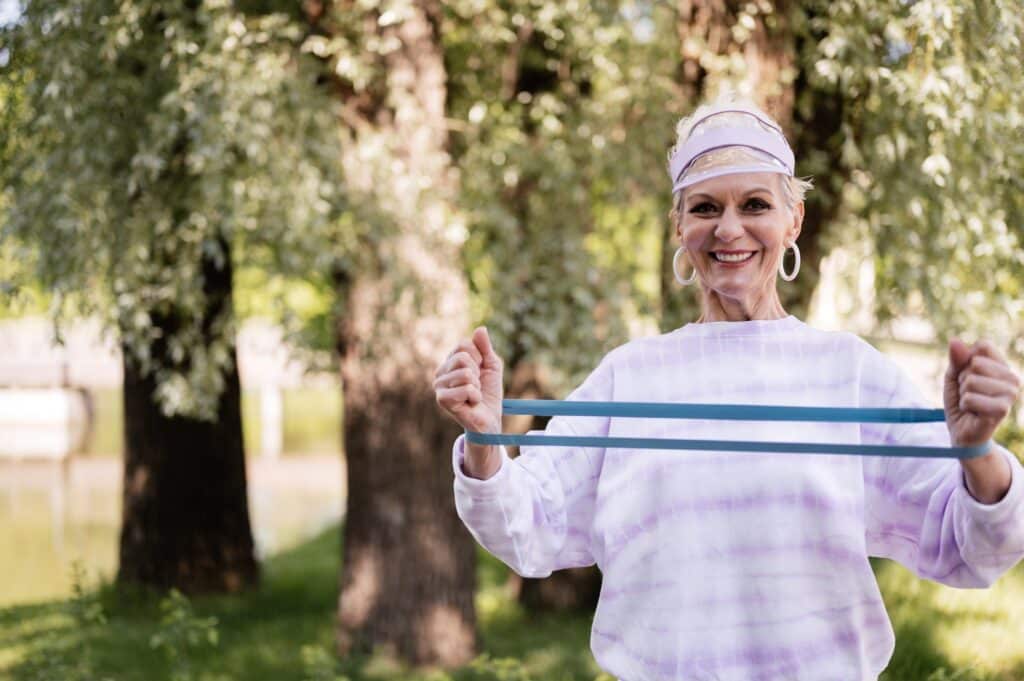
Of course, what’s even better than relieving your rotator cuff pain is healing the source of it entirely. In addition to helping your body heal the injury, this means building muscles to recover full strength and mobility. The following exercises are designed to target specific muscles involved in rotator cuff function to help you do just that.
It’s important to note that rehabilitation is unique to each person and their injury, and while incorporating rehabilitative exercises at home can be very beneficial to your recovery, it’s best to consult with a physical therapist or other medical professional.
External Rotation with Resistance Band: Strengthens the posterior deltoid, infraspinatus, and teres minor muscles within the rotator cuff to improve shoulder stability.
- Secure one end of a resistance band to a stationary object at waist height.
- Hold the other end with the hand of the injured shoulder, elbow bent at 90 degrees.
- Keeping the elbow close to the body, rotate the forearm outward against the resistance of the band.
- Slowly return to the starting position.
- Perform 2–3 sets of 10–15 repetitions.
Internal Rotation with Resistance Band: Strengthens the chest muscles to balance the forces acting on the shoulder joint and promote supportive posture.
- Secure one end of a resistance band to a stationary object at waist height.
- Hold the other end with the hand of the injured shoulder, elbow bent at 90 degrees.
- Keeping the elbow close to the body, rotate the forearm inward against the resistance of the band.
- Slowly return to the starting position.
- Perform 2–3 sets of 10–15 repetitions.
Standing Row: Strengthens the upper back muscles, promoting scapular retraction and stabilizing the shoulder blades to improve posture and support overall shoulder function.
- Secure one end of a resistance band to a stationary object at waist height.
- Hold the other end with the hand of the affected arm, elbow bent at 90 degrees.
- Keeping your arm by your side, slowly pull your elbow straight back.
- Slowly return to the start position
- Perform 2–3 sets of 10–15 repetitions.
Scapular Squeeze: Strengthens the upper back and shoulder blade muscles, including the rhomboids and middle trapezius, to improve overall stability and support shoulder mechanics.
- Stand, sit up straight, or lie flat on your stomach with your arms by your sides.
- Keeping your core engaged and your shoulders relaxed, slowly squeeze your shoulder blades together, focusing on pulling them toward each other.
- Hold the squeeze for 5–10 seconds before slowly releasing your shoulder blades to their starting position.
- Repeat 10–15 times.
Lateral Arm Raise: Strengthens the lateral deltoid muscles to improve shoulder stability and posture, supporting overall shoulder strength to relieve tension on the rotator cuff.
- Keep your arms straight, with palms facing inward toward your body.
- Slowly raise both arms out to the sides until they are parallel to the ground, maintaining a slight bend in the elbows.
- Pause briefly at the top of the movement, then lower the arms back down to the starting position.
- Add weight with a dumbbell as pain permits.
- Perform 2–3 sets of 10–15 repetitions.
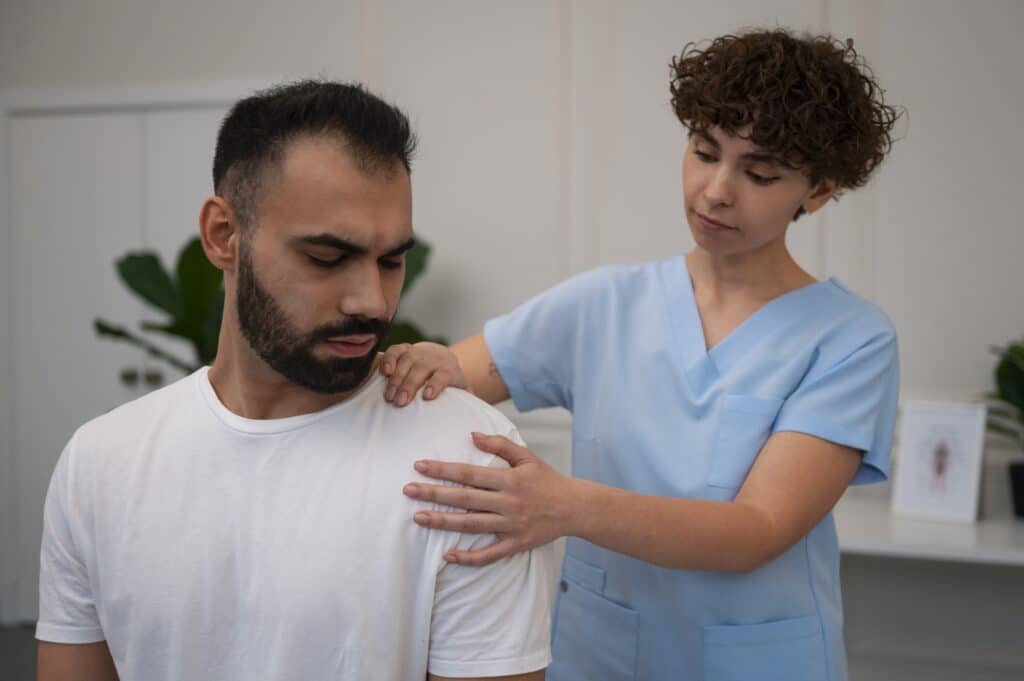
When to See a Doctor for Rotator Cuff Pain
It’s important to seek professional help for any rotator cuff injury beyond a mild sprain. This includes any injury that causes:
- Severe or persistent pain (If it keeps you up at night, that’s a sign of severe pain!)
- Limited range of motion
- Weakness or instability
- Swelling or bruising
With any of the above symptoms, it’s likely that you’ve experienced more than a mild sprain and that you’ll need professional rehabilitative support to heal efficiently and completely.
Relieving Rotator Cuff Pain with Atlanta Innovative Medicine
At Atlanta Innovative Medicine, we understand the impact that persistent rotator cuff pain can have on your daily life, particularly when it interferes with your sleep, hindering the body’s natural healing processes and keeping you stuck in a cycle of pain.
Fortunately, it’s possible to heal and relieve rotator cuff pain even without surgical intervention. Using a noninvasive, integrative approach, our team of experienced professionals work with your body to strengthen its capacity for healing, relieve your pain, and rebuild your strength.
We do this by combining physical therapy, chiropractic care, and advanced regenerative techniques that harness the power of your body’s healing factors, like platelet-rich plasma (PRP) or stem cells, to restore your body’s tissues completely.
If you’re seeking a holistic approach that doesn’t just relieve rotator cuff pain, but minimizes the risk of recurrence and future degeneration, Atlanta Innovative Medicine is here to help.
Contact us today to schedule a consultation and take the first step toward a fully healed shoulder and pain-free future.
Quizzes
Are you a candidate for Regenerative Medicine?
Regenerative medicine can be an effective therapy and treatment option for lasting pain relief for a variety of conditions like osteoarthritis of the knee, hip or shoulder; ACL or meniscus tears; tennis or golfer’s elbow; chronic neck and back pain; and more.
Is it right for you and your condition? Take 1 minute to answer a few “yes or no” questions that help to assess if you might be a candidate for PRP, stem cell or other nonsurgical regenerative treatments.
Are You a Stem Cell Candidate for Your Joint or Spine Damage?
Are you a candidate for Platelet Rich Plasma (PRP) Therapy?
Do I have nonsurgical options for my injured or aging joints?
Take the Pain Medications Risk Quiz
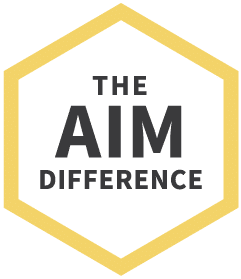
Regenerative Medicine.
Reimagined
- Advanced hybrid therapies, including Mesenchymal Stem Cell therapy combined with different mechanisms of action that synergistically come together to support ultimate healing
- More powerful PRP that’s customized, amplified and personalized
- Therapies delivered by an experienced, compassionate team comprised of multidisciplinary experts in traditional and alternative medicine working as your team: Medical Doctors, Nurse Practitioners, Physiotherapists and Chiropractors
- Advanced training through the American Academy of Orthopedic Medicine, the American Osteopathic Association of Prolotherapy Regenerative Medicine, and more
All content of this page is for informational purposes only and is not intended to serve as a substitute for the consultation, diagnosis, and/or medical treatment of a qualified physician or healthcare provider. Individual results may vary. Your medical professional can explain all the risks and potential benefits of any therapy based on your specific circumstances. At this time regenerative therapies are not FDA approved. Neither Atlanta Innovative Medicine nor its physician affiliates promise regenerative therapies as a cure for any condition, disease, or injury.
Other Atlanta Areas We Service:
© 2024 Atlanta Innovative Medicine, LLC. All Rights Reserved. AIM Scholarship Opportunity







